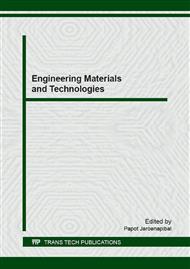[1]
A. Aubert, R. Gillet, A. Gaucher, J.P. Terrat, Hard chrome coatings deposited by physical vapour deposition, Thin Solid Films. 108 (1983) 165-172.
DOI: 10.1016/0040-6090(83)90501-1
Google Scholar
[2]
P.H. Mayrhofer, H. Willmann, C. Mitterer, Oxidation kinetics of sputtered Cr–N hard coatings, Surf Coat Technol. 146 (2001) 147: 222-228.
DOI: 10.1016/s0257-8972(01)01471-2
Google Scholar
[3]
J. Lin, W.D. Sproul, J.J. Moore, S. Lee, S. Myers, High rate deposition of thick CrN and Cr2N coatings using modulated pulse power (MPP) magnetron sputtering, Surf Coat Technol. 205 (2011) 3226-3234.
DOI: 10.1016/j.surfcoat.2010.11.039
Google Scholar
[4]
F. Ferreira, J.C. Oliveira, A. Cavaleiro, CrN thin films deposited by HiPIMS in DOMS mode, Surf Coat Technol. 291 (2016) 365-375.
DOI: 10.1016/j.surfcoat.2016.02.064
Google Scholar
[5]
A. Zeilinge, R. Daniel, T. Schöberl, M. Stefenelli, B. Sartory, J. Keckes, C. Mitterer, Resolving depth evolution of microstructure and hardness in sputtered CrN film, Thin Solid Films. 581 (2015) 75-79.
DOI: 10.1016/j.tsf.2014.10.106
Google Scholar
[6]
L. Shan, Y. Wang, J. Li, X. Jiang, J. Chen, Improving tribological performance of CrN coatings in seawater by structure design, Tribol Int. 82 (2015) 78-88.
DOI: 10.1016/j.triboint.2014.10.006
Google Scholar
[7]
B.D. Cullity, Elements of X-ray diffraction, 2e ed. California: Addison Wesley Publishing, (1977).
Google Scholar
[8]
L. Chekour, C. Nouveau, A. Chala, C. Labidi, N. Rouag. M.A. Djouadi, Growth mechanism for chromium nitride films deposited by magnetron and triode sputtering methods, Surf Coat Technol. 200 (2005) 241-244.
DOI: 10.1016/j.surfcoat.2005.02.062
Google Scholar
[9]
R. Wuhrer, W.A. Yeung, Comparative study of magnetron co-sputtered nanocrystalline titanium aluminium and chromium aluminium nitride coatings, Scripta Mater. 50 (2004) 144-146.
DOI: 10.1016/j.scriptamat.2004.03.007
Google Scholar
[10]
D.L. Smith, Thin-Film Deposition: Principle And Practice. New York, (1995).
Google Scholar
[11]
J.W. Lee, S.K. Tien, Y.C. Kuo, C.M. Chen, The mechanical properties evaluation of the CrN coatings deposited by the pulsed DC reactive magnetron sputtering, Surf Coat Technol. 200 (2006) 3330-3335.
DOI: 10.1016/j.surfcoat.2005.07.047
Google Scholar
[12]
N.B. Dahotre., S. Nayak, Nanocoatings for engine application, Surf Coat Technol. 194 (2005) 58-67.
Google Scholar


